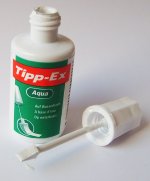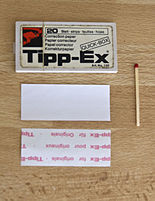This article has multiple issues. Please help improve it or discuss these issues on the talk page. (Learn how and when to remove these messages)
|

Tipp-Ex is a brand of correction fluid and other related products that is popular throughout Europe. It was also the name of the German company (Tipp-Ex GmbH & Co. KG) that produced the products in the Tipp-Ex line. While Tipp-Ex is a trademark name for correction products, in some countries it has become a genericised trademark: to tippex or to tippex out means to erase, either generally or with correction fluid.
History

Tipp-Ex correction paper was invented by Wolfgang Dabisch from Eltville, West Germany, who filed a patent in 1958 on Colored film for the correction of typing errors (German: Tippfehler). He subsequently founded a company of the same name. Shortly after that a Tipp-Ex Sales & Distribution company (Tipp-Ex Vertrieb GmbH & Co. KG) was founded in Frankfurt by Otto Carls. This company still exists under the name of Tipp-Ex GmbH & Co. KG close to Frankfurt. Tipp-Ex became a registered trademark with the German patent office in 1987.
Earlier, in 1951, Bette Nesmith Graham invented the first correction fluid in her kitchen and began marketing the product in 1956 as Mistake Out. Tipp-Ex GmbH only started to produce white correction fluid in 1965 under the brand Tipp-Ex, but also as C-fluid.
As a result of the invention of Tipp-Ex, it became possible to erase a typographical error made on a typewriter. The typewriter would be backspaced to the letter that was to be changed, the correction paper would be placed behind the ribbon, and the mistyped letter would be re-typed. The system only worked if the typewriter repositioned the re-typed letter in exactly the same place as originally typed, which could be problematic if returning to a previous line.
Demand for this correction paper grew very quickly and brought interest from German and international distributors.
In 1992 Tipp-Ex introduced its first correction tape, followed in 1995 by the successful Pocket Mouse which worked as a best seller. In 1998, the correction pen was launched. The range was extended to erasers, and in 2000, the new foam applicator was adapted to all the correction fluid bottles.
In 1997, Société Bic acquired Tipp-Ex.
Usage

Tipp-Ex correction fluid is a white liquid. It is used for painting over mistakes in a piece of writing. A brush (which was later replaced by a foam applicator) is attached to the cap, so when the bottle is closed, the brush is immersed in the fluid. When unscrewed, the brush is covered in liquid Tipp-Ex which is then painted over the mistake. However, it is still possible to see that the product has been used, and also the original content if the paper is held up to a light.
If the contents of a Tipp-Ex bottle have been exposed to too much air (for example, if the cap has been unscrewed too long or if the bottle is half-full and there is air filling the space), the fluid becomes thicker, and sometimes even solidifies. To help prevent this, Tipp-Ex released a product called "Tipp-Ex thinner", a few drops of which are mixed with the contents of a bottle of partially dried Tipp-Ex to thin it. This extends the lifetime of a bottle.
One must write with a ball point pen on top of Tipp-Ex, as a liquid ink pen will smudge. Gel ink will require a few seconds to fully dry, but can be used if no ball point pen is available.
Toxicology
The organic solvent 1,1,1-trichloroethane was originally used as a thinner in the product. This solvent is readily absorbed by the lungs via inhalation. It passes readily through the blood–brain barrier and may be lethal following acute exposure. 1,1,1-trichloroethane is also an 'ozone depleter', being one of the substances responsible for causing damage to the Earth's ozone layer. For both reasons, it has not been added to Tipp-Ex since 2000, and it has been replaced by aliphatic hydrocarbons.
See also
References
- "Has Tipp-Ex become a generic trademark?". 26 October 2020. Archived from the original on 21 September 2021.
- DE Patent 1192219B, Dabisch, Wolfgang, "Farbfolie zur Korrektur von Tippfehlern", issued 6 May 1965
- "DPMAregister Marken - Registerauskunft". Deutsches Patent und Merkenamt (in German).
- "Bette Nesmith Graham" (PDF). Celebrating Texas. Retrieved 18 March 2010.
- Le groupe Bic achète l'allemand Tipp-Ex, Les Echos, January 1997
- "Monograph For UKPID 1,1,1-trichloroethane". National Poisons Information Service (London Centre). 1 December 1995. Archived from the original on 1 July 2011.
- "Environment Agency 1,1,1-trichloroethane". Environment Agency. 4 April 2011. Archived from the original on 4 February 2009.
- "Safety Data Sheet for Tipp-Ex" (PDF). The Consortium. June 2000. Archived from the original (PDF) on 25 November 2011.
External links
 Media related to Tipp-Ex at Wikimedia Commons
Media related to Tipp-Ex at Wikimedia Commons